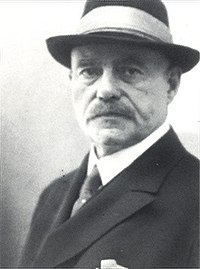The Butterfly Battle (1924)
| Movie | |
|---|---|
| Original title | The butterfly battle |
| Country of production | Germany |
| original language | German |
| Publishing year | 1924 |
| length | 105 minutes |
| Rod | |
| Director | Franz Eckstein |
| script |
Rosa Porten Willy Rath |
| production | National-Film AG (Berlin) |
| camera | Frank Stein |
| occupation | |
| |
The butterfly battle is a German silent film drama in 1924. Under the direction of Franz Eckstein play Asta Nielsen , Lori Leux , Mary Parker and Adele Sandrock the female leads. Reinhold Schünzel and Gregori Chmara are at your side . The film is based on the play of the same name (1894) by Hermann Sudermann .

action
Germany at the end of the 19th century. Ms. Hergentheim, the widow of a tax inspector, lives under one roof with her three daughters, Rosi, Else and Laura, some of whom are already grown up. The young women earn their living as employees of the fan factory of the Winkelmann family. They draw butterfly patterns for their products. Ms. Hergentheim wants to know that her daughters are “well married” so that they no longer have to worry about finances. Else Hergentheim is the oldest and has already been divorced once. Mother Hergentheim wants nothing more than that Else becomes engaged to the manufacturer's son Max.
Else feels drawn to the alert traveling salesman Richard Kessler, a nonchalant man of the world. Her younger and rather gullible, if not to say naive, sister Rosi serves as the postillon d'amour between the two lovebirds. A secret meeting between Else and Kessler leads to Mrs. Hergentheim's future son-in-law Max Winkelmann becoming suspicious. Rosi steps in for Else again and claims that she actually had an appointment with Kessler. Now the entire family structure in the Hergentheim house begins to slip ...
Production notes, publication
The shooting of The Butterfly Battle took place in the Berlin National Film Atelier in mid-1924. The film passed the censorship on September 18, 1924 and was premiered on November 14, 1924 in Berlin's Alhambra cinema. The strip had six files, spread over a length of 2,635 meters, and was banned from minors.
The film structures were created by Prof. Max Frick.
Worth knowing and reception
Sudermann's play, originally intended as a social tragedy, was not a success when it was first performed in Germany and Austria-Hungary in 1894/95 and was mistakenly viewed as a comedy. The film adaptation was not well received by its critics either, while Asta Nielsen's performance was praised.
“... there are all kinds of film talents, big, beautiful talents, here and over there; but there is only one film genius in the world; and this genius is called Asta Nielsen. "
Web links
- The butterfly battle in the Internet Movie Database (English)
- The butterfly battle at filmportal.de